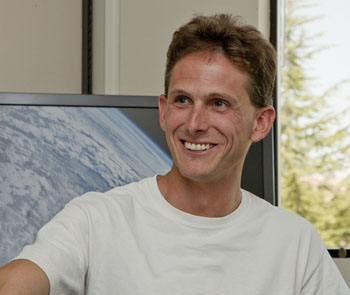ACADEMIA
A drive to solve problems in all aspects of life earns Banks a presidential early career award
Whether the challenge is academic or athletic, Laboratory computational scientist Jeff Banks has always set the bar high.
In the end, hurtling down a runway to pole vault to a new height and grappling with a complex computational problem to take simulation to a new level tap the same inner drive. Banks, a pole vaulter in college, notes that technical people are often attracted by the thrill of both physical and mental problem solving.
"We're adrenalin junkies working on a challenge or problem until we get it right," Banks said. "Figuring out and preparing to vault to a new height is a little like working on a math problem." Banks' problem solving prowess and community mindedness earned him a 2012 Presidential Early Career Award for Scientists and Engineers (PECASE). The award ceremony was held Tuesday at the Smithsonian National Museum of Natural History in Washington, D.C.
Banks was selected for work in computational physics, scientific computation and numerical analysis, especially pioneering contributions in numerical approximations to hyperbolic partial differential equations focusing on the development and analysis of nonlinear and high-resolution finite-volume and finite-difference methods, and for service in high schools and the scientific community.
In lay terms, "My research is about using computers to simulate problems from the physical sciences, and I work on the basic mathematics needed to continue expanding our simulation capabilities," said Banks, who works in the Center for Applied Scientific Computing. While Banks was aware he had been nominated for the prestigious award, "I was surprised and honored to be selected for a PECASE award."
Banks' work to improve computer simulations is important to national security research, notably fusion experiments at the National Ignition Facility vital to the National Nuclear Security Administration's program to ensure the safety, security and reliability of the nation's nuclear deterrent without underground testing. NIF also serves as a fusion energy test bed.
Banks is particularly interested in wave problems such as those often found in fluid dynamics or electromagnetics.
In addition to his LLNL research, Banks tutors high school students with the goal of making math more accessible and less intimidating. "Math scares kids and it shouldn't be that way."
He also coaches track and field at a local high school. He met his wife, Cara, now a high school math teacher at Amador High School in Pleasanton, on the pole vault runway at Rensselaer Polytechnic Institute (RPI). Never one to stand on the sidelines, Banks took up the hammer throw when injury prevented him from pole vaulting. Post-college, he started running to slake his competitive drive. If his name sounds familiar to employees, it may be because Banks won last year's edition of the Run-for-HOME, covering the 2,500 meters in a speedy 8:25.
Banks, a native of Salt Lake City, Utah, received his Ph.D. in applied mathematics from RPI in May of 2006 and has been an employee of LLNL since February 2008, first as a post-doctoral fellow and then as a member of the technical staff. He also completed his undergraduate and master's degrees in mathematics at RPI in Troy, New York. He came to LLNL as a summer student in 2004 and 2005, and returned as a postdoc in 2008.
When it comes to his professional achievements, Banks is quick to credit the college mentors who gave him directions and his LLNL mentor Bill Henshaw as well as colleagues who provide an environment in which he is able to thrive. In addition, he and his group have benefitted from the Lab's emphasis on innovative work, notably the Laboratory Directed Research and Development program. Banks and his wife have a 1-year old daughter, Eliana, who's already showing some of her track and field heritage. Given the circumstances of her parents meeting and their love of track and field, he joked, "She's doomed."
No doubt about it, those are some long strides down the runway she's going to follow.
